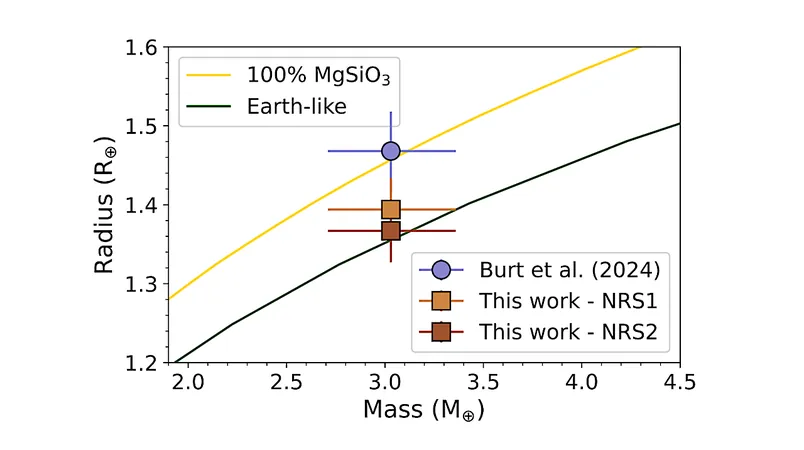
Unveiling the Cosmos: The Groundbreaking Discovery of Twin Stars Dancing Around a Galactic Giant
2024-12-17
Author: Sarah
In a momentous stride for astronomy, researchers have made a revolutionary discovery at the heart of our Milky Way galaxy. It is there, approximately 27,000 light-years from Earth, that resides the supermassive black hole known as Sagittarius A*. With a diameter of an astonishing 23.5 million kilometers, this cosmic giant continues to be a focal point of scientific inquiry.
Led by Florian Peißker from the University of Cologne, a dedicated team of astronomers has reported the first-ever detection of a binary star system, dubbed D9, orbiting this formidable black hole. This groundbreaking finding, detailed in a recently published paper in Nature Communications, provides unprecedented insights into the extreme conditions prevailing in our galaxy's core and may help decipher the enigma of hypervelocity stars—those celestial bodies moving at breakneck speeds of over 1,000 kilometers per second.
What is a Binary Star System?
For the uninitiated, a binary star system is a celestial pairing where two stars orbit around a common center of mass. This relationship is pivotal in astronomical studies—while our Sun is a solitary star, it is estimated that approximately two-thirds of the stars in the Milky Way exist within such arrangements. The implications of this finding stretch far beyond simple star classification; they offer a treasure trove of data that can unveil the mass and characteristics of these stellar bodies.
The Challenges of Discovery
Detecting such binary systems near supermassive black holes presents immense challenges. Astronomers cannot rely on direct observation due to vast distances; instead, they employ advanced techniques like the Doppler effect. Using the European Southern Observatory’s Very Large Telescope, the team identified the unique "wobble" in starlight that hinted at the existence of this binary system.
At about 2.7 million years old, these stars likely did not form within the gravitational grasp of Sagittarius A*. Instead, they presumably originated in a less hostile environment, surviving in this perilous vicinity for around a million years—an incredible feat given the disruptive nature of black holes.
The Dance of Celestial Bodies
Similar gravitational dynamics govern our Solar System, illustrating how objects like the Moon orbit the Earth while both revolve around the Sun. In complex systems where multiple bodies interact, gravitational forces can lead to dramatic escapades—potentially ejecting one star from its companions entirely, a scenario that may explain the phenomenon of hypervelocity stars.
Since the mid-2000s, astronomers have cataloged about 20 such stars, which zip through our galaxy at speeds vastly exceeding those typical of galactic orbits. The current hypothesis suggests these hypervelocity stars were once part of binary systems that ventured too close to Sagittarius A*, leading to the violent ejection of one star while the other remains trapped in orbit.
Future Explorations and Theories
The implications of discovering D9 stretch beyond its immediate findings. The existence of binary star systems near supermassive black holes may unlock further secrets of cosmic evolution. The proximity of these stars to Sagittarius A* can provide a clearer understanding of the mechanisms behind hypervelocity stars, further cementing our comprehension of galactic dynamics.
As astronomers continue their monitoring efforts of the galactic center alongside advanced observational techniques, the mysteries surrounding black holes and their stellar companions will inevitably unfold—offering thrilling avenues for discovery and perhaps even redefining our understanding of the universe.
Stay tuned as the journey through the cosmos reveals more wonders; who knows what astonishing revelations are waiting just beyond the next star?



 Brasil (PT)
Brasil (PT)
 Canada (EN)
Canada (EN)
 Chile (ES)
Chile (ES)
 España (ES)
España (ES)
 France (FR)
France (FR)
 Hong Kong (EN)
Hong Kong (EN)
 Italia (IT)
Italia (IT)
 日本 (JA)
日本 (JA)
 Magyarország (HU)
Magyarország (HU)
 Norge (NO)
Norge (NO)
 Polska (PL)
Polska (PL)
 Schweiz (DE)
Schweiz (DE)
 Singapore (EN)
Singapore (EN)
 Sverige (SV)
Sverige (SV)
 Suomi (FI)
Suomi (FI)
 Türkiye (TR)
Türkiye (TR)